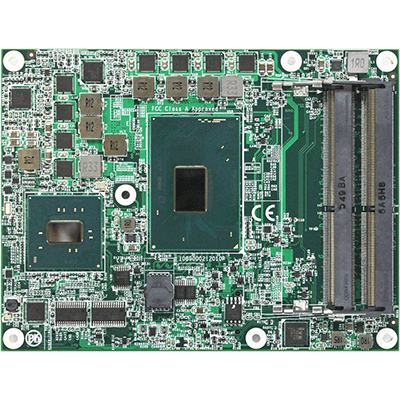What Is a COM Express?

A COM Express (Computer On Module) is a COM standard defined by PICMG.
It refers to the adoption of technologies such as PCI Express and Serial ATA to existing COM. A COM Express board typically includes a CPU, memory, bus interface, and more, and it is connected to a carrier board and a card carriage. It is a device that can fully function as a computer.
The adoption of COM Express in products allows for speedy product development, simplified development, and reduced development costs. It also improves the future potential of the product, as modules compatible with the COM Express standard will be available in the market in the future.
Uses for COM Express
COM Express is used in a wide range of applications and industries due to its flexibility and scalability. Below are some key use cases:
1. Industrial Computers
In industrial applications such as factory automation, industrial control, and robotics, COM Express provides robustness and reliability in computer systems. Customizable features and expandability are essential to meet the specific requirements these applications.
2. Medical Equipment
For applications in the medical field, such as diagnostic and therapeutic equipment, COM Express offers reliability and high performance. Fast data processing and real-time responsiveness are critical elements in the diagnosis and treatment of patients.
3. Aviation and Defense Industry
COM Express modules are widely used in applications requiring high performance and reliability in the aviation and defense industry, such as aircraft navigation systems and military communications equipment. In these industries where robustness and long-term support are required, COM Express provides the ideal solution.
4. Telecommunication Networks
COM Express provides high-speed data transfer and high reliability to meet the requirements of telecommunication infrastructures. In devices such as network switches and routers, COM Express provides a reliable, high-performance platform.
Principle of COM Express
COM Express comprises a board with interfaces that can be connected to the CPU, memory, bus, USB, and other components. It also includes a card carriage insert and a connection to a carrier board. It can be mounted on a carrier board, and new modules can be inserted into the carrier board to expand the functionality of the product.
PCI Express, the technology used in COM Express, is a standard for expansion slots that can exchange electrical signals at high speed, allowing the insertion of graphics cards and other devices. Serial ATA, another technology used in COM Express, is a standard for connecting hard disks and other devices to COM Express, allowing them to exchange data at high speed.
Types of COM Express
COM Express offers a variety of form factors and pin assignments, depending on the application and requirements. The most typical of these are four form factors and three pin assignments.
1. Classification by Form Factor
- COM Express Mini
The smallest model, designed for applications requiring an extremely small footprint. It is typically found in mobile devices and small devices. - COM Express Compact
Slightly larger than the COM Express Mini, this model offers more computing power and connectivity options. Its compact design makes it suitable for a wide variety of applications. - COM Express Basic
The most common form factor, offering a wide range of I/O and high-performance computing options. They are widely used in industrial equipment, networking equipment, and other high-performance systems. - COM Express Extended
The largest form factor, offering the most high-performance computing capability and the broadest range of I/O options. It is designed for the most demanding applications.
2. Classification by Pinout
- Type 6
The most common pinout, providing common I/O and display interfaces. It is typically used in applications where graphics processing power is critical. - Type 7
Optimized for server applications and provides 10 Gigabit Ethernet (10GbE) and additional PCI Express (PCIe) lanes instead of a display interface. - Type 10
This pinout is dedicated to COM Express Mini and prioritizes miniaturization and ruggedness. It is typically found in mobile and low power applications.
Thanks to these types, COM Express can adapt to a wide variety of requirements and applications and meet the needs of any industry. This is one of the reasons why COM Express is widely adopted in the industry.